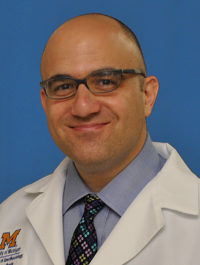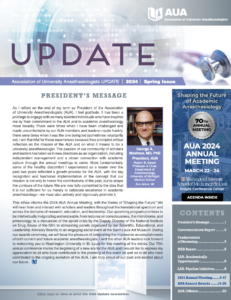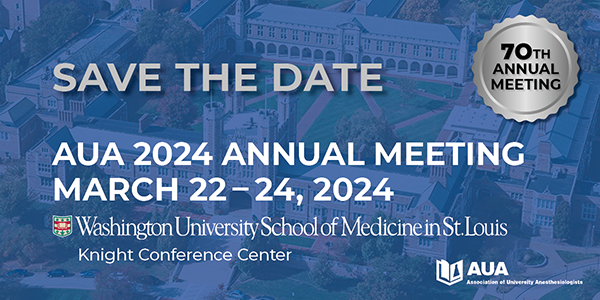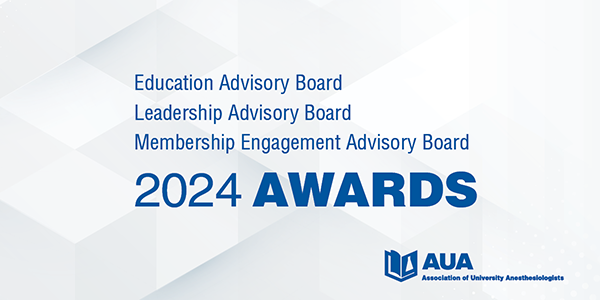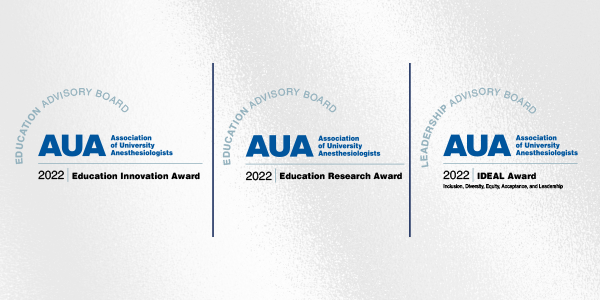President’s Message: Addressing Sexual Harassment in Academic Anesthesiology
In July 2022, the Association of American Medical Colleges (AAMC) published the report “Understanding and Addressing Sexual Harassment in Academic Medicine.” The focus was on academic physicians and the data were based on the AAMC StandPoint™ Faculty Engagement Survey, administered from 2019-2021. There were responses from 13,239 full- and part-time faculty members across 22 U.S. medical schools. The focus of the report was gender-based harassment, which can be defined as “verbal and nonverbal behaviors that convey hostility, objectification, exclusion, or second-class status about members of one gender,” and which is a common form of sexual harassment.
The AAMC report revealed that, of 27 clinical and basic science disciplines, the field of anesthesiology was #1 for percentage of women (52.6%) and men (21.3%) experiencing gender-based harassment in the 12 months prior to survey administration. Harassment has a negative impact on wellbeing, professional development, and career satisfaction.
This is shocking—and not acceptable. As we continue to process this disturbing report, I would like to offer five points for consideration that I have described in a recent article for the ASA Monitor (April, 2023).
- We should not dismiss these data. Survey methodology has limitations, but it is important to remember that biases in sampling or response should affect all 27 disciplines that were evaluated. In other words, there is no obvious reason why anesthesiology should be skewed in this survey. Furthermore, for medical students considering the field, the perception is the reality: the AAMC has now reported that academic anesthesiology is the worst field in medicine for gender-based harassment. If you were a medical student that was deciding between, for example, anesthesiology (with the highest incidence of harassment) and urology (with the lowest), which would you choose? The implications of these data have consequences for the future of our field.
- We should not assume this only happens in other anesthesiology departments. As leaders in academic anesthesiology, we should resist the tendency to respond to uncomfortable data with the attitude “yes, but not in my department.” We need to reflect critically on our own cultures and policies because this is a pervasive issue. We also need to reflect on our own identities and how that might affect our perception of the problem in our local environments. As a middle-aged, white, cis-male in a leadership position, my personal experience of gender-based harassment is going to be vastly different than someone without such privilege. This isn’t about being “woke,” but simply recognizing the fact that my lived experience is not the lived experience of someone else.
- We should not assume that people outside of anesthesiology are the only perpetrators of harassment. One natural response to these data is “It’s the surgeons!” Anesthesiologists do, indeed, interact with a wide array of clinicians in other specialties and it is important to consider the wider culture of our healthcare ecosystem as we tackle this problem. However, we need to start this journey with critical reflection on ourselves and our own culture. Furthermore, even if we did assume that the source of harassment was from outside our own field, how have we empowered our own team members to address this? How have we trained our own colleagues in bystander interventions? How robust is our reporting system for harassment and how thorough is our response? We need to start with our own departments first.
- We should recognize that the problem extends far beyond the focus of the AAMC report. As noted above, the methodology of the AAMC focused only on gender-based harassment and only with faculty; the diversity of the respondents has been questioned, which limits inferences. The report does not speak at all to the experiences of our medical students, interns, residents, and fellows. It does not speak to the experiences of private practice colleagues or the CRNAs with whom we work. Although the data certainly are relevant to the AUA constituency of academic faculty, we must recognize that other professional colleagues are being affected and, furthermore, gender-based harassment is only one form of sexual harassment, and sexual harassment is only one form of harassment.
- We should gather more information and then act. Some of the points above speak to the need for more information. Are academic anesthesiology faculty only the victims of gender-based harassment, or are they also perpetrators? Where and when does gender-based harassment most often occur? The list of questions can go on, but it is critically important to ensure that the acquisition of new knowledge serves as a preparation for action, not as a delay tactic. We need to do something and, fortunately, the AAMC has some recommendations as starting points. Academic medicine and anesthesiology need to commit to structural changes that will endure beyond the emotions we might be experiencing in response to this report.
Anesthesiology should be free from all forms of harassment. Everyone, regardless of gender or other personal characteristics, has the right to work and develop their careers in peace. The AUA is unequivocally committed to advancing this goal and we are actively working toward it. Dr. Maya Hastie, in collaboration with the AUA Leadership Advisory Board and colleagues from the British Medical Association, developed a survey to address unanswered questions from the AAMC report. This has now been disseminated across U.S. and Canadian medical schools, with almost six hundred respondents at this point. We will analyze these data, present preliminary findings at our annual meeting, and move forward with recommendations for positive action.
AUA members are leaders and, as leaders, it is our responsibility to advance a culture in which every person in every anesthesiology department across the country can actualize their full potential, so that we as a field can actualize our full potential and continue to make important contributions to medicine, science, and society.
Acknowledgments: The author would like to thank Dr. Dolores Njoku, Washington University, President-Elect of the AUA, and Dr. Maya Hastie, Columbia University, Chair of the AUA Leadership Advisory Board, for their thoughtful review and helpful comments.
Read Dr. Mashour’s article, “This is Not Acceptable,” in ASA Monitor: Volume 87 | Number 4 | April 2023.
